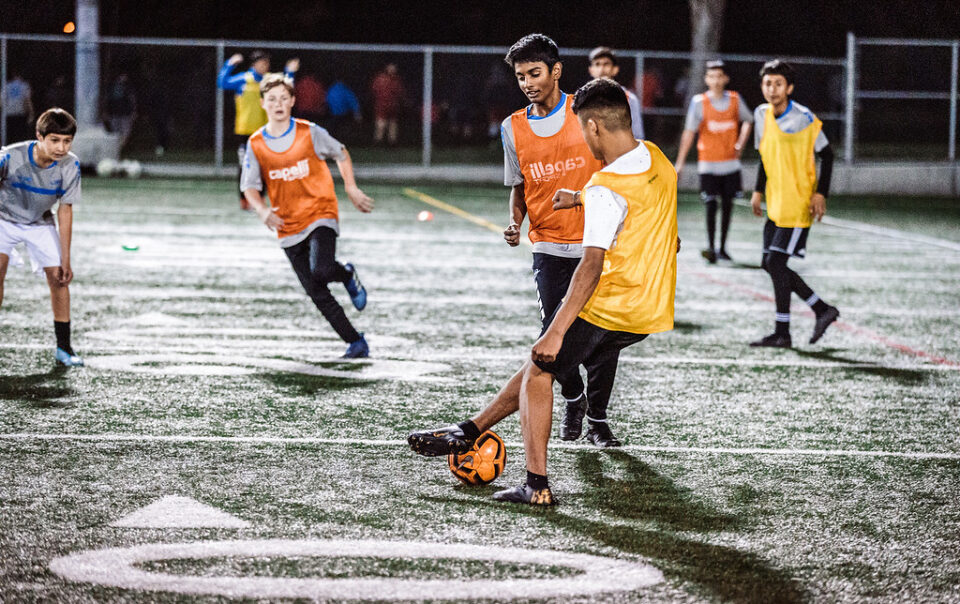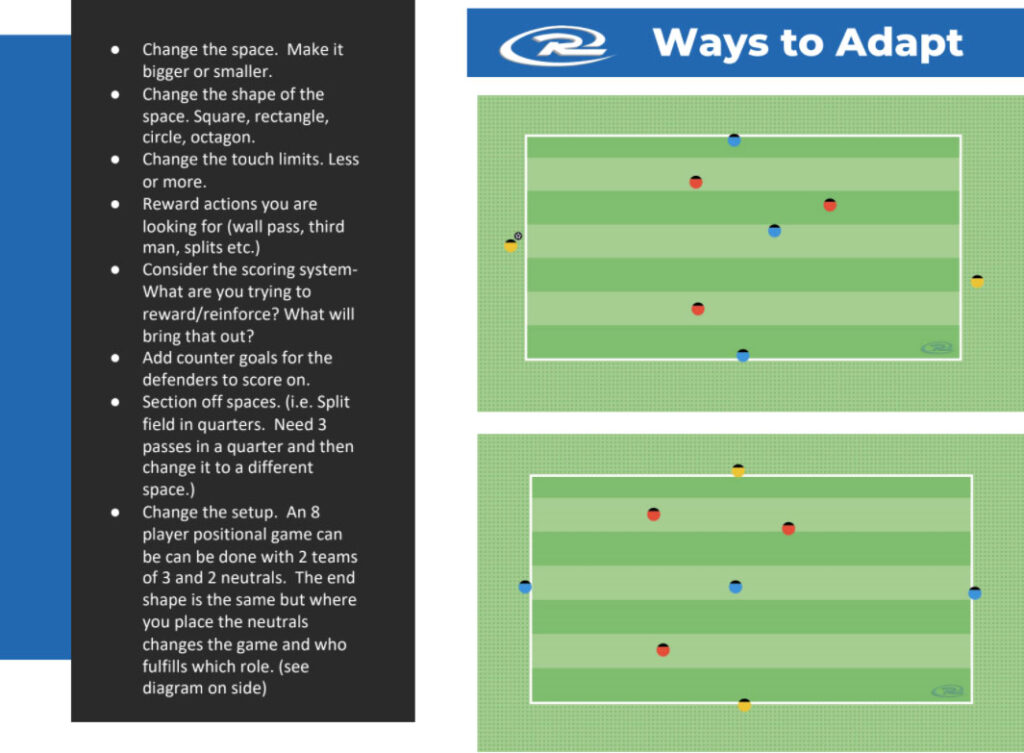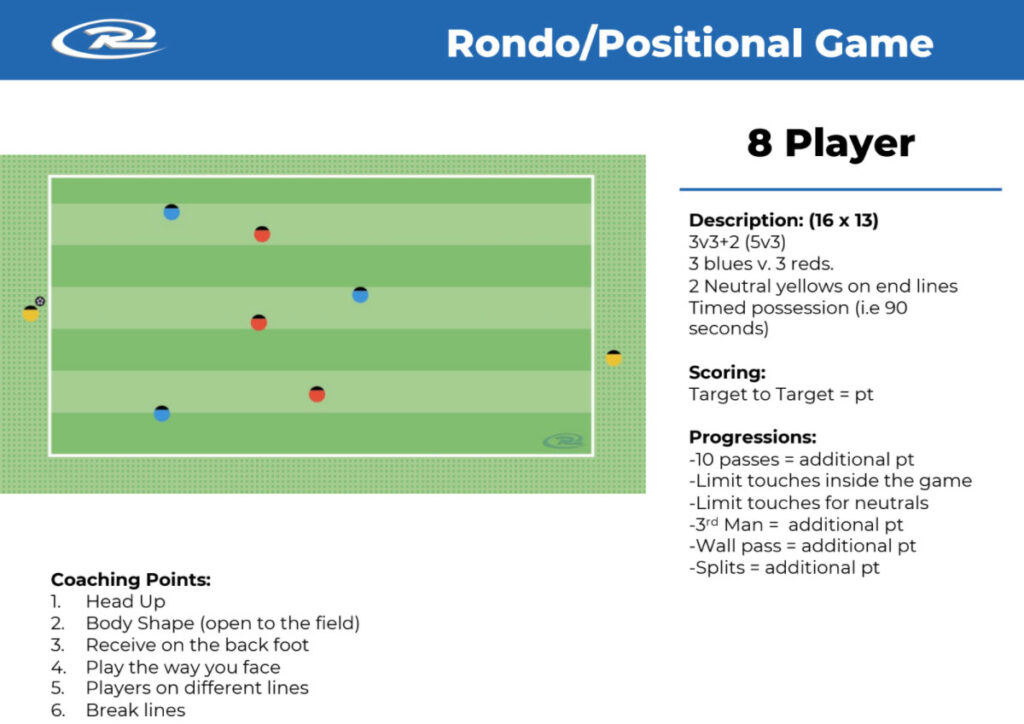Rondos and Positional Games are very popular training activities. We will dive into the benefits of these type of drills while applying The Rush Way through our Blue Thread.
“Everything that goes on in a match, except shooting, you can do in a rondo. The competitive aspect, fighting to make space, what to do when in possession and what to do when you haven’t got the ball, how to play ‘one touch’ soccer, how to counteract the tight marking and how to win the ball back.”
Johan Cruyff.
Why Rondos & Positional Games? To answer this question, Kevin Sakuda -Director of Coaching at Washington Rush- put together this amazing piece of content in which he analyzes some of the many benefits that these type of activities offer for player development:
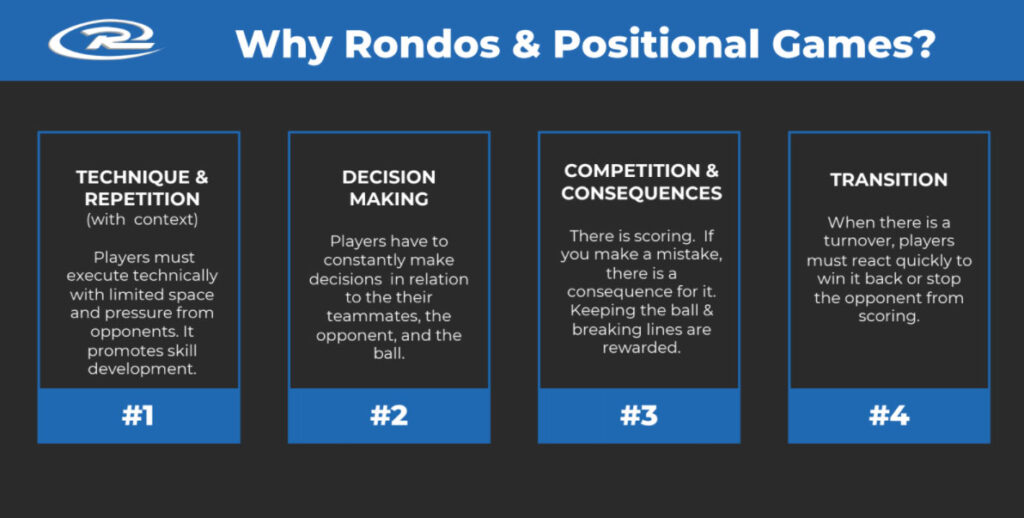
“In addition to these, there are many other benefits to using rondos and positional games within your session, including the coaching of defensive and pressing principles. There is directionality. There is teamwork involved. It promotes cognitive development. It promotes character development. There are technical and tactical implications. There is creativity. Rondos are fun and engaging. They are player centered. All players are actively involved in the exercise. The same rondo set up can be used to coach a variety of technical and tactical concepts. It lays the architecture for our system of play and reinforces our principles of play.“
Scroll down to find more info and/or download WA Rush’s PDF Guide on Rondo & Positional Games!
“It’s all about rondos . Rondo, rondo, rondo. Every. Single. Day. It’s the best exercise there is. You learn responsibility and not to lose the ball. If you lose the ball, you go in the middle. Pum-pum-pum-pum, always one touch.”
Xavi Hernández.
We constantly hear about Rondos and Positional Games. They are similar but actually not the same thing. The main difference between Rondos and Positional Games is that, in the first one, players occupy preset spaces as opposed to a more random space, while in the second one, players take similar positions as in the real game. Here’s a couple of examples:
Are these type of activities adequate to apply the Rush Blue Thread? In many cases, yes.
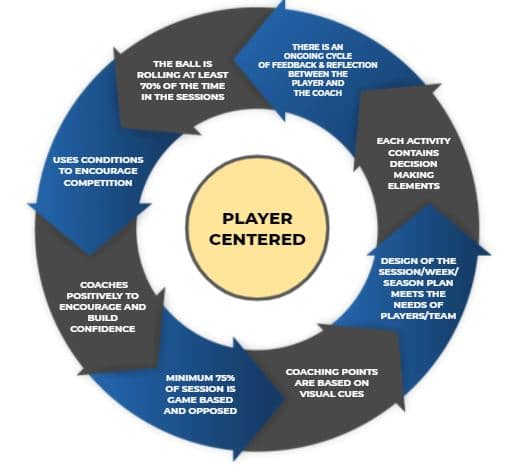
Many of the Rush Blue Thread elements can be applied through them:
• There is an ongoing cycle of feedback & reflection between the player and coach: A cycle of feedback of reflection is not built overnight, obviously. It deeply relies on your ability to connect with the players and make them feel comfortable with opening up, ask questions, and receive feedback. Once that’s accomplished, these activities can be an instrument to facilitate posing questions.
• Each activity contains decision making element: Naturally, these activities imply making decisions within the proposed game situation.
• Coaching points are based on visual cues: Positional games, if well applied, can facilitate the recreation of specific game situations and allow coaches the opportunity to present coaching points using visual cues.
• The ball is rolling at least 70% of the time: Definitely. One of the main advantages of these games is that the ball is constantly in play.
• A minimum of 75% of the session is game based and opposed: Rondos are naturally game based and opposed. If you are teaching a specific passing pattern or technique, for example, you could introduce that skill unopposed (if needed, it depends), and then play a rondo game to further teach and show the decision making associated with the situation.
• Uses conditions to encourage competition: Rondo games can be structured to have a clear winner and loser. It can be based on playing into a goal, target, or a set number of passes. Be sure to use a set duration that is appropriate, especially when playing a numbers up rondo. The defenders need to be encourage to go at their maximum to properly stress the team in possession.
When should we use rondos and positional games?
Rondos and positional games are normally applied in the first two stages of a session, either as a warm up or as a positional activity prior to an specific small sided activity. This session from The Rush Coaching Manual shows a clear example of the aforementioned concept.
What to avoid when using rondos and positional games:
The application of rondos, however, is not always appropriate. Frequently, we see rondos or positional games that are misplaced on the field or in which the activity does not provide the adequate feedback of the game situation that it intends to represent. Please note that we are talking about the feedback from the activity, not from the coach. This is a simple concept to exemplify: Imagine that you want your players to react quickly upon losing possession of the ball. Simply observe your activity and ask yourself: Is the activity demanding that from the players? If so, is it doing it in the right direction?
The following activity presents what we consider a great example of a well applied positional activity:
Here is why:
- The transition in the activity is realistic for both teams. The team playing out of the back needs to compress the space and the team that wins the ball back needs to score quickly, what is once again a realistic game situation.
- The spacing is correct, the activity takes place in the right area of the field.
- The direction is adequate. The team building up needs to play forward and the team that defends, upon winning the ball back, needs to attack towards the full size goal.
- The players’ positions are realistic. Center backs, wing backs, midfielders, and offensive midfielders play in the same areas they would do it in a real game situation.
FIND BELOW CONCRETE EXAMPLES TO APPLY IN YOUR SESSIONS!
Sean Connors, Rush Soccer’s Global Goalkeeping Director & Director of Soccer at Washington Rush, shared with us Kevin Sakuda’s guide with options for rondos and positional games in different numbers. Click HERE to read and/or Download!


